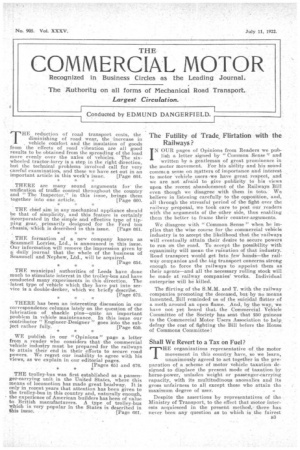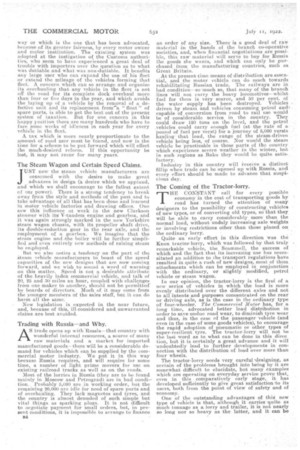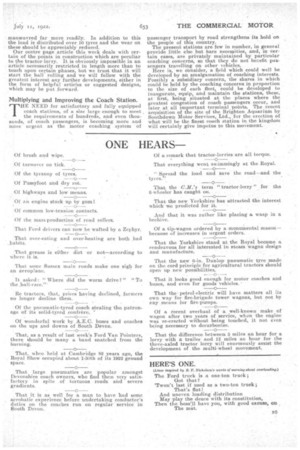The Futility of Trade. Flirtation with the Railways ?
Page 1

Page 2

Page 3

If you've noticed an error in this article please click here to report it so we can fix it.
IN OUR pages of Opinions from Readers we publish a letter signed by "Common Sense '4 and written by a gentleman of great prominence in the motor movement. For his ability and his sound commcn sense on matters of importance and interest to motor 'vehicle users we have great respect, and we are not afraid to give publicity to his views upon the recent abandonment of the Railways Bill even though we disagree with them in toto. We believe in listening carefully to the opposition, and, all through the stressful period of the fight over the railway proposal, we took care to post Our readers with the arguments of the other side, thus enabling them the better to frame their counter-arguments.
We disagree with "Common Sense" when he implies that the wise course for the commercial vehicle industry is to accept the likelihood that the railways will eventually attain their desire to secure powers to run o'n the road. To accept the possibility with equanimity will mean the ruination of that industry. Road transport would get Into few hands—the railway companies and the .big transport concerns strong enough to force the railways to appoint them as their agents—and all the necessary rolling stock will be made at railway companies' works. Individual enterprise will be killed.
The flirting of the S.M.M. and T. with the railway companies promoting the deceased, but by no means lamented, ,Bill reminded us of the suicidal flutter of a moth around an open flame. .And, by the way, we have not yet heard that, the Commercial Vehicle Committee of the Society has Bent that 250 guineas to the Commercial Motor Users Association to help defray the cost of fighting the Bill before the House of Commons Committee I ShallWe Revert to a Tax on Fuel?
HE organizations representative of the motor movement in this country have, so we learn, unanimously agreed to act together in the pre. naration of a scheme of motor vehicle taxation dc• signed to displace the present mode of taxation by horse-power, unladen weight or passenger-carrying capacity, with its multitudinous anomalies and its gross unfairness to all except those who attain the maximum degree of user.
Despite the assertions by representatives of the Ministry of Transport, to the effect that motor interests acquiesced in the present method, there has never been any question as to which is the fairest
way or which is the one that has been advocated, because of its greater fairness, by every motor owner and motor institution. The existing system was adopted at the instigation of the Customs authorities, who seem to have experienced a great deal of trouble with importers oyer the 'question as to what was dutiable and what was non-dutiable. It benefits any large user who can expand the use of his fleet or extend the mileage of the vehicles forming. that fleet. A concern which can so arrange and organize its overhauling that any vehicle in the fleetis not off the road for its complete dock overhaul more than four or five days in the year, and which avoids the laying up of a vehicle by the removal of a defective unit and its replacement from-% " float " of spare parts, is able to get the best out of the present system of taxation. But for one -concern in this happy position there are many hundreds who have to face aome weeks of idleness in each year for every
vehicle in the fleet. .
A tax which is more nearly proportionate to the amount of road user must be found, and now is the time for a seherms to be put forward which will effect the much-desired reform. If this opportunity be lost, it may not recur for many years.
The Steam Wagon and Certain Speed Claims.
JUST now the steam .vehicle manufacturers are consumed with the desire to make great .advances in design (a desire which we applaud, and which we Shall encourage to the fullest extent of our power). There is a strong tendency to break away from the style and methods of the past and to take advantage of all that has been done and learned in motor vehicle factories and drawing offices. One saw this influence at work in the new Clarkson steamer with its V-tandem engine and gearbox, and it was again strongly marked in the new Yorkshire steam wagon chassis, with its propeller shaft drive, its double-reduction gear in the rear axle, and the employment of a gearbox. We imagine that the steam engine and the boiler will be further simplified and even entirely new methods of raising steam
be employed. .
But we also notice a tendency on the part of the Steam vehicle manufacturers to boast of the speed capacities of the new designs that are now coming forward, and we wish to sound a word of warning. on this matter. Speed is not a desirable attribute of the heavily laden commercial vehicle, and talk of 20, 25 and 30 miles an hour, coupled with challenges from one maker to another, should not be permitted: by boards of directors. Much of it may come from the younger members of the sales staff, but it can do harm all the same'.
New legislation is expected in the near future, and, because of this, ill-considered and unwarranted claims are best avoided.
Trading with Russia—and Why.
As trade opens up with Russia—that country with wonderful internal resources, a source of many raw materials and a Market for imported manufactured goods-there will be a considerable demand for vehicles which can be supplied by the commercial motor industry. We put it in this way because Russia requires, and will require for some time' a number of light prime movers for use on existing railroad tracks as well as on the roads.
Most of the lorries in Russia (they are to be found mainly in Moscow and Petrograd) are in bad condition. Probably 5,000 are in working order, but the remaining 20,000 are idle for need of spare parts and of overhauling. They lack magnetos and tyres, and the country is almost denuded of such simple but vital things as sparking plugs. It is not difficult to negotiate payment for small orders, but, in present conditions, it is impossible to arrange to finance
an order of any size. Thereis a good deal of ravy Material in the hands of the branch co-operative societies, and, when financial negotiations are possible, this raw material will serve to buy for Russia the goods she wants, and which can only be purchased from the manufacturing countries, such as Great Britain.
At the present time means of distribution are essential, and the motor vehiclo can do much towards rehabilitating Russian trade. The railways are in . bad condition—so-much so, that many of the branch lines will not carry the heavy locomotives—whilst. fuel for them is very scarce, and 50 per cent. of the water supply has been destroyed. Vehicles , driven by steam and vehicles consuming petrol and? capable of conversion from road to rail use would be of considerable service in the country. They could draw 120 tons on the level, and the petrol vehicles could carry enough fuel (at the rate of a pound of fuel per verst) for a journey of 5,000 versts haulingthat load, the range of the steam-driven vehicle being less, of course. Nor would the steam vehicle he 'practicable in those parts of the country which experience severe weather in the winter, but in such regions as Baku they would be quite satisfactory.
Industry in this country will receiVe a distinct fillip when trade can be opened up with Russia, and every effort should be made to advance that auspicious day.
The Coming of the Tractor-lorry.
THE 'CONSTANT call for every possible economy in the cost of transporting goods by road has turned the attention of many designers to the possibility of constructing vehicles of new types, or of converting old types, se that they will be able to carry considerably more than the normal load, without unduly increasing axle weights or involving restrictions other than those placed on the ordinary lorry. Quite an early effort in this direction was the Knox tractor-lorry, which was followed by that truly remarkable vehicle, the Scamrnell, the success of which and the fact that its increasing use has necessitated an addition to the transport regulations have resulted in quite a rush of new designs, most of them
i attachments which can be employed n conjunction with the ordinary, or slightly modified, petrol vehicle or steam wagon.
In our opinion, the tractor-lorry is the first* of a new series of vehicles in which the load is more evenly distributed over the different axles and not to all intents and purposes concentrated on the rear or driving axle, as is the case in the ordinary type of four-wheeler. The Commercial Motor has, for a long time, advocated better load distribution in order to save undue road wear, to diminish tyre wear and thus, in the case of the passenger vehicle(and even in the case of some goods vehicles), to encourage the rapid adoption of pneumatic or other types of super-resilient tyre. The tractor-lorry will not be the last word as to what can be done in this dime . tion, but it is certainly a great advance and it will -undoubtedly lead to further developments in connection with the distribution of load over more than four wheels.
The tractor-lorry needs very careful -designing, as certain of the problems brought into being by it are somewhat difficult to elucidate, but many examples which are operating on everyday service prove that, even in this coinparatiyely early stage, it has developed sufficiently to give great satisfaction to its users, both from the point of view of safety and of -economy. One of the outstanding advantages of this new type of vehicle is that,. although it carries 'quite as much tonnage as a lorry and trailer, it is not nearly so long nor so heavy as the latter, and it can be
rnanceuvred far more readily. In addition to this the load is distributed over 10 tyres and the wear on these should be appreciably reduced. Our centre page article this week deals with certain of the points in construction which are peculiar to the tractor-lorry. It is obviously impossible in an article necessarily restricted in length more than to touch upon certain phases, but we trust that it will start the ball' rolling and we will follow with the greatest interest any further developments, either in the form of helpful articles or suggested designs, which may be put forward.
Multiplying and Improving the Coach Station. THE NEED for satisfactory and fully equipped coach stations, of a size large enough to meet the requirements of hundreds, and even thousands, of coach passengers, is becoming more and more urgent as the motor coaching system of
passenger transport by road strengthens its hold on the people of this country.
The present stations are few in number, in general provide little else but bare necessities, and, in certain cases, are privately maintained by particular coaching concerns, so that they do not benefit passengers travelling on other -vehicles.
Here is, we cbrisider, a field which could well be developed by an amalgamation of coaching interests. Possibly a subsidiary concern, the shares in which could be held by the coaching concerns in proportion to the size of each fleet, could be developed to inaugurate, equip, and maintain the stations, these, at first, being situated at the places where the greatest congestion of coach passengers occur, and later at all important terminal points. The recent acquisition of the site of the Brighton Aquarium by Southdown Motor Services, Ltd., for the erection of what will be the finest coach station in the kingdom will certainly give impetus to this movement.






























